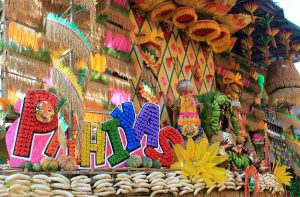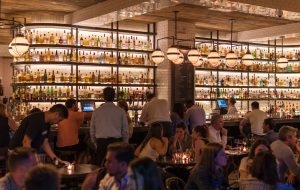- Ayala Triangle Gardens – is a 2-hectare (4.9-acre) landscaped urban park in Makati, Metro Manila, Philippines. It is a triangular public garden and courtyard in the center of the Makati Central Business District. It was named after its owner and developer Ayala Land, and opened to the public in November 2009. Inspired by Hyde Park in London, the park, which is dotted with palms, acacia trees, and tropical foliage, is considered as one of the few “green” areas in Makati. The Triangle has become a focal point for social events in the business district, and is popular at Christmastime for its extravagant light-and-sound display. It is also home to the Tower One and Exchange Plaza and Makati Stock Exchange Building, as well as the old Nielson Tower which houses the Filipinas Heritage Library.
- Makati Park and Garden – sometimes called Fort Bonifacio Riverside Park and Liwasang Bonifacio (lit. Bonifacio Park) by local residents, is an urban riverfront park along the south bank of the Pasig River in Makati, Metro Manila, Philippines. It is the largest public park in Makati with an area of 35,433 square metres (381,400 sq ft). The park is under the management of the Parks and Green Division of Makati’s Department of Environmental Services. It was created in 2001 as part of the Linear Parks Project of the Pasig River Rehabilitation Commission.
- Salcedo Park – Jaime C. Velasquez Park, commonly referred to as Salcedo Park, is a pocket park in Makati, Metro Manila, the Philippines. It is one of four pockets of green located in the central business district within the former Salcedo Village, now part of Bel-Air Village. The park is the site of a popular weekend market called the Salcedo Community Market. It is also the main venue of the bi-annual contemporary art fair called Art in the Park.
- Washington SyCip Park – is a privately owned public park near Greenbelt mall in Legaspi Village, Makati, Metro Manila, Philippines. The park opened in 2006, and was named after Filipino accountant and banker Washington SyCip. In addition to many indigenous tropical trees and plants, the park contains gazebos, benches with quotes by Sycip, sculptures and a koi pond.The park is open daily from 06:00 to 22:00 PST (GMT+8). It is a no-smoking, no pet zone.
- Arroceros Forest Park – is a riverside park in Manila, Philippines, located on Antonio Villegas Street (former Calle Arroceros) in the central district of Ermita. Developed in 1993, the 2.2-hectare (5.4-acre) urban forest on the south bank of the Pasig River, at the foot of Quezon Bridge, consists of secondary growth forest with 61 different tree varieties and 8,000 ornamental plants providing a habitat for 10 different bird species.[1] Despite its small size, it is considered an important feature of the city. It lies in a historic area of Manila and has been called “Manila’s last lung”, being the city’s only nature park.[2] The park is administered by the City Government of Manila in partnership with private environmental group, Winner Foundation.
- Baywalk -is a seaside promenade overlooking Manila Bay along Roxas Boulevard in the city of Manila, Philippines. The Baywalk is a two-kilometre stretch from the US Embassy and the Cultural Center of the Philippines (CCP) just past the Manila Yacht Club.
- Manila Zoo – formally known as the Manila Zoological and Botanical Garden, is a 5.5-hectare (14-acre) zoo located in Malate, Manila, Philippines that opened on July 25, 1959.
- Mehan Garden – is an open space in Manila, Philippines. It was established in 1858 by the Spanish colonial authorities as a botanical garden, called the Jardín Botánico, outside the walled city.
- Paco Park – (originally named as Cementerio General de Dilao) is a recreational garden and was once Manila’s municipal cemetery built by the Dominicans during the Spanish colonial period. It is located on General Luna Street and at the east end of Padre Faura Street in Paco, Manila, Philippines. Paco Park has also become a very popular venue for weddings and receptions for couples who prefer garden-like settings.
- Rizal Park – also known as Luneta Park or simply Luneta, is a historical urban park in the Philippines. Located along Roxas Boulevard, Manila, adjacent to the old walled city of Intramuros, it is one of the largest urban parks in Asia. It has been a favorite leisure spot, and is frequented on Sundays and national holidays. Rizal Park is one of the major tourist attractions of Manila.
- Pinaglabanan Shrine – is a Filipino national shrine and park along Pinaglabanan Street in the city of San Juan, Metro Manila, Philippines. Prominent within the shrine is a statue of elongated figures known as “Spirit of Pinaglabanan” created by Eduardo Castrillo. This was built to commemorate the heroism of the Katipuneros who started the nationwide revolution in San Juan del Monte. The local freedom fighters known as katipuneros lay siege to an arms storage facility, called the ‘Polvorin de Almacen’, belonging to the Spanish Colonial Government.
- Quezon Memorial Circle – is a national park located in Quezon City, which became the capital of the Philippines from 1948 to 1976. The park is located inside a large traffic circle in the shape of an ellipse and bounded by the Elliptical Road. Its main feature is a 66-metre (217 ft) tall mausoleum containing the remains of Manuel L. Quezon, the second official President of the Philippines and the first of an internationally recognized independent Philippines, and his wife, First Lady Aurora Quezon.This location will be the street alignment for the approved Manila Metro Rail Transit System Line 7 named Quezon Memorial MRT Station and the station will be underground.”Circle”, as locals call it, has been undergoing significant changes in order to lure in more tourists both local and foreign. Due to these beautification efforts of the local government the number of visitors is continuously increasing.
- Balara Filters Park – is a 60-hectare (150-acre) park located in the Diliman village of Pansol in Quezon City, Metro Manila, Philippines, adjacent to the University of the Philippines Diliman main campus. It is bounded by Katipunan Avenue on the west, Capitol Hills Golf and Country Club on the north, and the upscale, gated village of La Vista along its south and east. The park is one of the oldest recreation areas in Quezon City having been first opened to the public in 1953. It occupies part of the old Balara Filtration Plant complex, one of the main treatment facilities for water coming from the La Mesa Dam. The park is administered by the Manila Water company in partnership with the Quezon City Parks Development and Administration Department.
- Freedom Island – is an artificial island in Manila Bay just off the coast of Parañaque in Metro Manila, Philippines. It was formed between 1973 and 1985 during the construction of the Manila–Cavite Coastal Road. Two other islands lie immediately to the south in Las Piñas, namely Long Island and another smaller island also formed by land reclamation. The islands form the Las Piñas–Parañaque Critical Habitat and Ecotourism Area.
- Ninoy Aquino Parks and Wildlife Center – is a 22.7-hectare (56-acre) zoological and botanical garden located in Diliman, Quezon City, the Philippines. It was named after Benigno S. “Ninoy” Aquino, Jr. The Ninoy Aquino Parks & Wildlife Center has a lagoon, an aquarium, a playground, botanical garden and a Wildlife Rescue Center, which the Department of Environment and Natural Resources uses as a temporary shelter where confiscated, retrieved, donated, sick, abandoned, and injured wild animals are placed to be taken care of. The park houses several indigenous plants and animals such as crab-eating macaques, water monitors, Philippine deer, binturongs, Palawan bearded pigs and several varieties of birds.
- Pasig Rainforest Park – also known as Pasig City Rainforest Adventure Experience (RAVE Rainforest Park) and Pasig Central Park,[1] is a public park in Pasig, eastern Metro Manila, Philippines. It spans 8 hectares (20 acres), and is a mixed recreational and natural park with a mini-zoo.
- Glorieta Park – sometimes spelled Glorietta Park, is an urban park in Caloocan, northern Metro Manila.
- Malabon People’s Park – also known as Catmon People’s Park, is an urban park situated in the densely populated village of Catmon, in the northern Metro Manila city of Malabon.
- Marikina River Park – is a system of parks, trails, open spaces and recreation facilities along an 11-kilometre (6.8 mi) stretch of the Marikina River in Marikina, eastern Metro Manila.
- Navotas Centennial Park – is a waterfront park in Navotas, Metro Manila, the Philippines, facing the Manila Bay. It is the largest open space in the city and is CAMANAVA or North Manila District’s version of the Baywalk.




